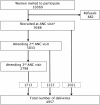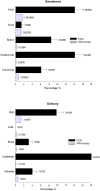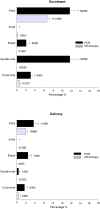Burden and impact of Plasmodium vivax in pregnancy: A multi-centre prospective observational study
- PMID: 28604825
- PMCID: PMC5481034
- DOI: 10.1371/journal.pntd.0005606
Burden and impact of Plasmodium vivax in pregnancy: A multi-centre prospective observational study
Abstract
Background: Despite that over 90 million pregnancies are at risk of Plasmodium vivax infection annually, little is known about the epidemiology and impact of the infection in pregnancy.
Methodology and principal findings: We undertook a health facility-based prospective observational study in pregnant women from Guatemala (GT), Colombia (CO), Brazil (BR), India (IN) and Papua New Guinea PNG). Malaria and anemia were determined during pregnancy and fetal outcomes assessed at delivery. A total of 9388 women were enrolled at antennal care (ANC), of whom 53% (4957) were followed until delivery. Prevalence of P. vivax monoinfection in maternal blood at delivery was 0.4% (20/4461) by microscopy [GT 0.1%, CO 0.5%, BR 0.1%, IN 0.2%, PNG 1.2%] and 7% (104/1488) by PCR. P. falciparum monoinfection was found in 0.5% (22/4463) of women by microscopy [GT 0%, CO 0.5%, BR 0%, IN 0%, PNG 2%]. P. vivax infection was observed in 0.4% (14/3725) of placentas examined by microscopy and in 3.7% (19/508) by PCR. P. vivax in newborn blood was detected in 0.02% (1/4302) of samples examined by microscopy [in cord blood; 0.05% (2/4040) by microscopy, and 2.6% (13/497) by PCR]. Clinical P. vivax infection was associated with increased risk of maternal anemia (Odds Ratio-OR, 5.48, [95% CI 1.83-16.41]; p = 0.009), while submicroscopic vivax infection was not associated with increased risk of moderate-severe anemia (Hb<8g/dL) (OR, 1.16, [95% CI 0.52-2.59]; p = 0.717), or low birth weight (<2500g) (OR, 0.52, [95% CI, 0.23-1.16]; p = 0.110).
Conclusions: In this multicenter study, the prevalence of P. vivax infection in pregnancy by microscopy was overall low across all endemic study sites; however, molecular methods revealed a significant number of submicroscopic infections. Clinical vivax infection in pregnancy was associated with maternal anemia, which may be deleterious for infant's health. These results may help to guide maternal health programs in settings where vivax malaria is endemic; they also highlight the need of addressing a vulnerable population such as pregnant women while embracing malaria elimination in endemic countries.
Conflict of interest statement
The authors have declared that no competing interests exist.
Figures



References
-
- Guerra CA, Snow RW, Hay SI: Mapping the global extent of malaria in 2005. Trends Parasitol 2006, 22(8):353–358. doi: 10.1016/j.pt.2006.06.006 - DOI - PMC - PubMed
-
- Hay SI, Guerra CA, Tatem AJ, Noor AM, Snow RW: The global distribution and population at risk of malaria: past, present, and future. Lancet Infect Dis 2004, 4(6):327–336. doi: 10.1016/S1473-3099(04)01043-6 - DOI - PMC - PubMed
-
- Baird JK: Neglect of Plasmodium vivax malaria. Trends Parasitol 2007, 23(11):533–539. doi: 10.1016/j.pt.2007.08.011 - DOI - PubMed
-
- Mueller I, Galinski MR, Baird JK, Carlton JM, Kochar DK, Alonso PL, del Portillo HA: Key gaps in the knowledge of Plasmodium vivax, a neglected human malaria parasite. Lancet Infect Dis 2009, 9(9):555–566. doi: 10.1016/S1473-3099(09)70177-X - DOI - PubMed
Publication types
MeSH terms
Grants and funding
LinkOut - more resources
Full Text Sources
Other Literature Sources
Miscellaneous

